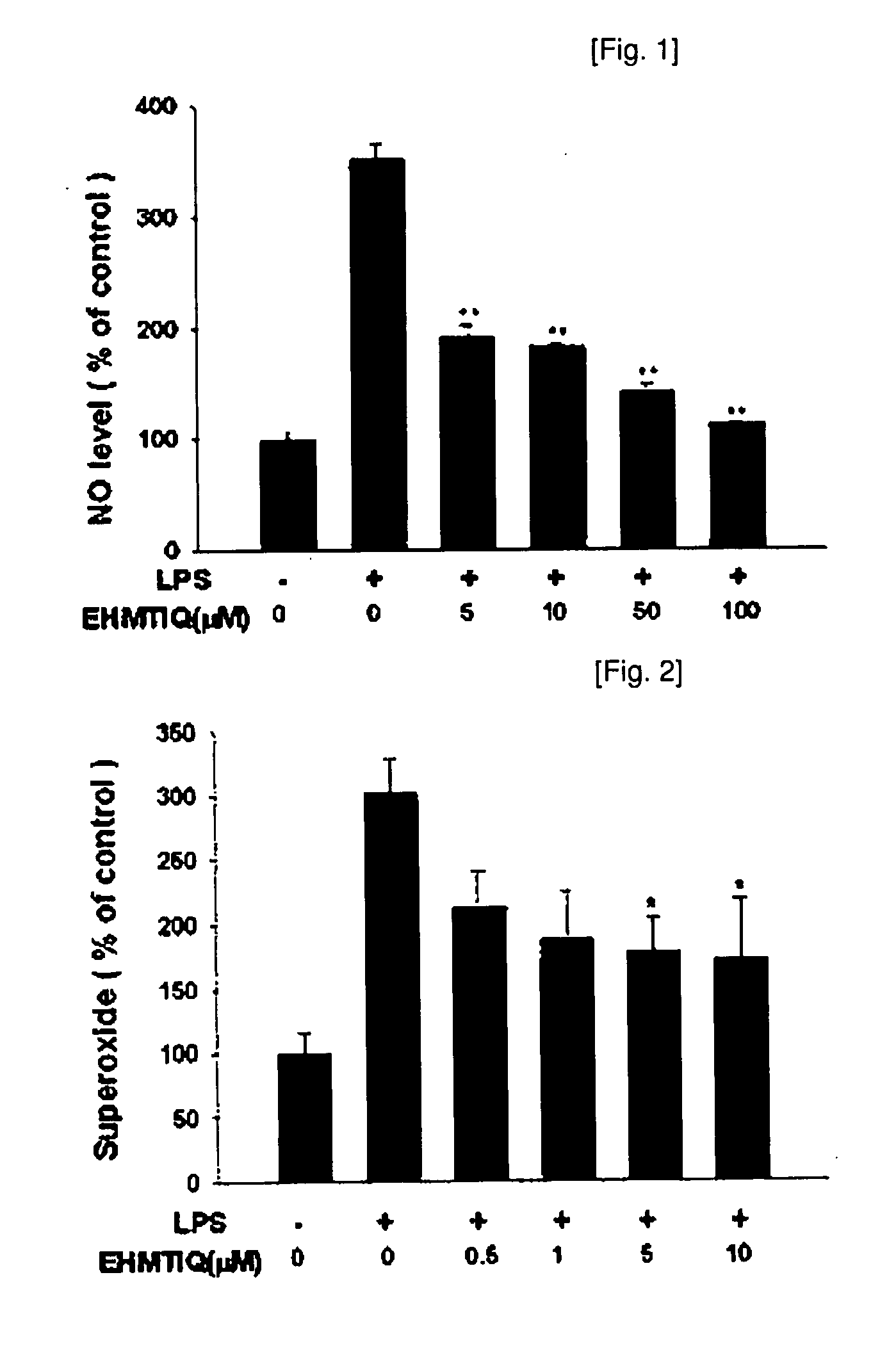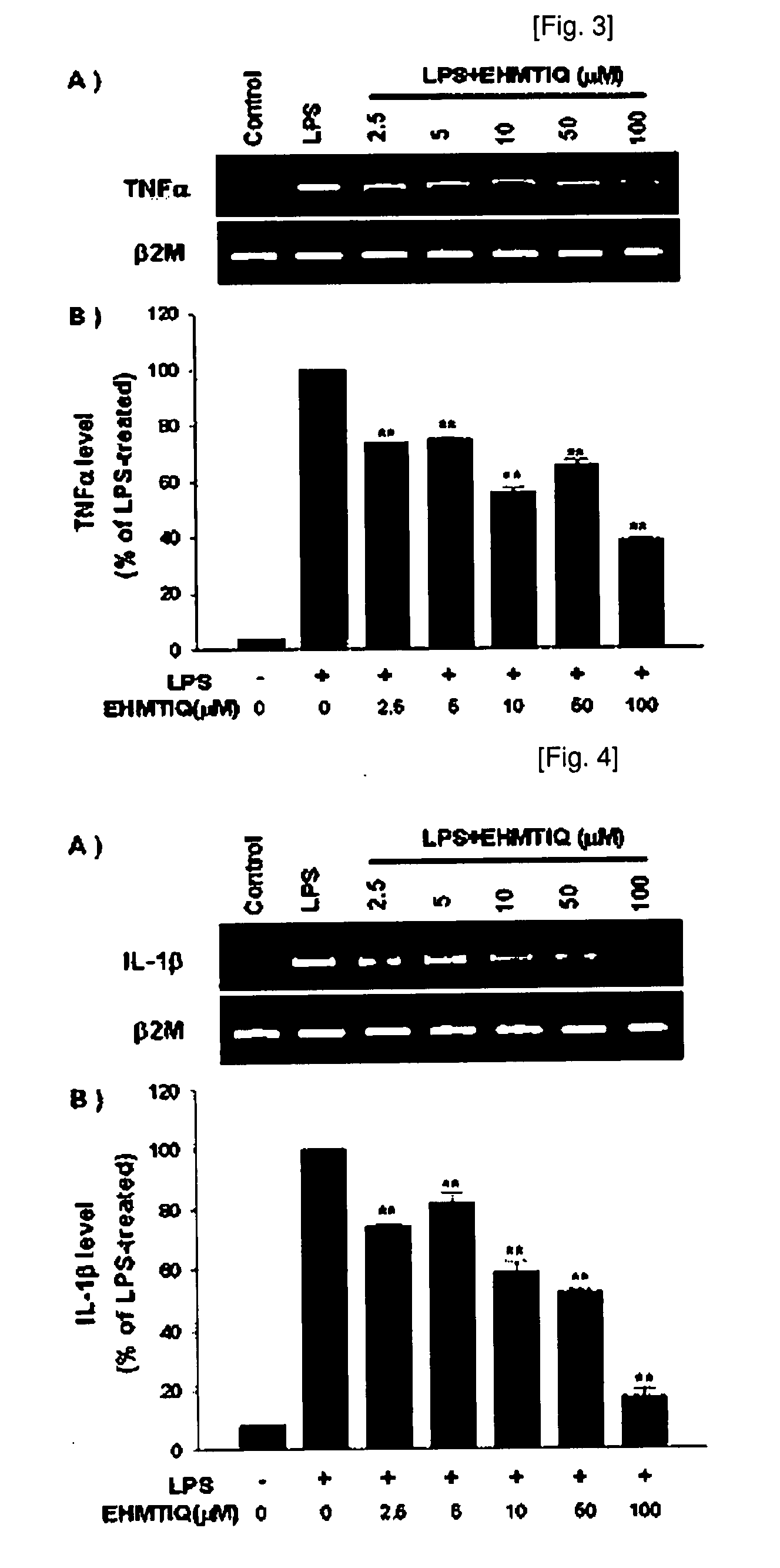1,2,3,4-tetrahydroisoquinoline derivatives having effects of preventing and treating degenerative and inflammatory diseases
a technology of tetrahydroisoquinoline and derivatives, which is applied in the field of 1,2,3,4-tetrahydroisoquinoline derivatives having the effect of preventing and treating degenerative and inflammatory diseases, can solve the problems of neurodegenerative diseases going from bad to worse, loss of adjacent neurons, so as to reduce the production of ros
- Summary
- Abstract
- Description
- Claims
- Application Information
AI Technical Summary
Benefits of technology
Problems solved by technology
Method used
Image
Examples
exemplary embodiment 1
Synthesis of 2-acetyl-7-hydroxy-6-methoxy-1,2,3,4-tetrahydroisoquinoline (AHMTIO) Derivatives, Substituted with Methyl or Phenyl in C1 Position and Analysis of their Structures
[0056]
[0057]Preparation and Analysis of AHMTIQ (5a)
[0058]Acetaldehyde (15.7 mmol, 692 mg) was reacted with 3-O-methyl dopamine hydrochloride (1.96 mmol, 400 mg) dissolved in 1M HCl solution (10 ml) in a pressure tube for 24 hours at 100° C. The reaction tube was cooled and the mixture was neutralized with sodium bicarbonate. Water and the remaining solvent were removed under reduced pressure and the result was dried in a vacuum. Methanol was added to filter remaining precipitate and crude compound 4a was extracted by short column chromatography. The crystallization of the crude compound 4a yielded a white powdery hydrochloride salt (250 mg, 55%) [1H NMR (DMSO-d6, 400 MHz) δ9.93 (br s, 1H), 9.40 (br s, 1H), 9.06 (s, 1H), 6.72 (s, 1H), 6.67 (s, 1H), 4.32-4.30 (m, 1H), 3.47 (s, 3H), 3.28-3.36 (m, 1H), 3.21-3.22 (...
exemplary embodiment 2
Synthesis Method of AHMTIQ Derivatives (6, 7a-h, 8a-h and 9a-g) Substituted with Several Alkyls in C1 Position and Analysis of their Structures
[0064]
[0065]① Synthesis Method and Analysis of N-(2-(4-hydroxy-3-O-methylphenyl)ethyl)-tertiary butyl carbonate (6)
[0066]Method a) Tertiary butyl oxycarbonyl anhydride (7.63 mmol, 1.67 g) and triethylamine (19.5 mmol, 1.93 g) were added to chloroform (20 ml) with compound 3 (6.35 mmol, 1.30 g). The mixture was stirred for 24 hours at RT and aluminum chloride solution was added thereto. The mixture was extracted with a dichloromethane solvent and then the organic layer was washed twice with water. A white crystalline compound (1.32 g, 59%) was yielded by column chromatography and recrystallization [1H NMR (CDCl3, 200 MHz) δ6.83 (d, J=8.4 Hz, 1H), 6.63-6.67 (m, 2H), 5.83 (s, 1H), 6.45 (br s, 1H), 3.84 (s, 3H), 3.35 (q, J=6.6 Hz, 2H), 2.70 (t, J=7.0 Hz, 2H), 1.43 (s, 9H); 13C NMR (CDCl3, 50 MHz) δ155.9, 146.5, 144.1, 130.6, 121.2, 114.4, 111.2, ...
exemplary embodiment 3
Synthesis Method of 7-hydroxy-6-methoxy-1,2,3,4-tetrahydroisoquinoline (HMTIO) Derivatives (11a-e and 12a-f) Substituted with Amides and Alkyls in N2 Position and Analysis of their Structures
[0096]
① Preparation and Analysis of HMTIO Derivatives (11a-e) Substituted with Amides in N2 Position
[0097]Preparations a) and b) Compound 10 (1.0 or 2.0 mmol) was dissolved in a dichloromethane solvent (10-15 ml), and alkylacyl chloride (propionic anhydride, butyryl chloride, cyclohexanecarbonyl chloride, isobutyryl chloride or 3-methylbutyryl chloride) was gently added thereto. Triethylamine (3.0 or 6.0 mmol) was gently added and the mixture was stirred at RT for about one hour. The reaction was quenched with water and the organic layer was washed with water. The solvent was removed under reduced pressure. The resultant compound was dissolved in methanol (10-20 ml) and calcium carbonate (3.0 or 6.0 mmol) was added thereto, followed by refluxing of the mixture for about 2 to 3 hours. The refluxe...
PUM
 Login to View More
Login to View More Abstract
Description
Claims
Application Information
 Login to View More
Login to View More - R&D
- Intellectual Property
- Life Sciences
- Materials
- Tech Scout
- Unparalleled Data Quality
- Higher Quality Content
- 60% Fewer Hallucinations
Browse by: Latest US Patents, China's latest patents, Technical Efficacy Thesaurus, Application Domain, Technology Topic, Popular Technical Reports.
© 2025 PatSnap. All rights reserved.Legal|Privacy policy|Modern Slavery Act Transparency Statement|Sitemap|About US| Contact US: help@patsnap.com



